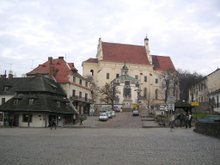Kazimierz Dolny
| Kazimierz Dolny | ||
|---|---|---|

|
|
|
| Basic data | ||
| State : | Poland | |
| Voivodeship : | Lublin | |
| Powiat : | Puławy | |
| Gmina : | Kazimierz Dolny | |
| Area : | 30.42 km² | |
| Geographic location : | 51 ° 19 ′ N , 21 ° 57 ′ E | |
| Height : | 200 m npm | |
| Residents : | 2597 (December 31, 2016) | |
| Postal code : | 24-120 | |
| Telephone code : | (+48) 81 | |
| License plate : | LPU | |
| Economy and Transport | ||
| Next international airport : | Warsaw | |
| administration | ||
| Website : | www.kazimierzdolny.pl | |
Kazimierz Dolny is a Polish city in the Lublin Voivodeship in the powiat Puławy . It is located on the eastern bank of the Vistula , about 40 km west of Lublin and is the seat of the urban and rural community of Kazimierz Dolny . The city of Kazimierz Dolny itself has about 2600 inhabitants and is a well-known and popular tourist destination all over Poland because of its historic old town.
history
The beginnings of the place go back to the 11th century. On one of the hills there was a settlement called Wietrzna Góra , which belonged to the Benedictines . In 1181 Duke Kazimierz the Righteous transferred the place to the Premonstratensian choirs from Cracow - Zwierzyniec , who renamed it Kazimierz in his honor . It was first mentioned in a document in 1249 . The nickname "Dolny" (= lower / lower) was added later with reference to the location on the Vistula to differentiate Kazimierz Dolny from Kazimierz near Krakow. In 1325, King Władysław I. Ellenlang donated a church, today's parish church. In the first half of the 14th century a castle was also built and town charter was granted, probably by King Casimir I the Great . In 1406, under Władysław II Jagiełło, another city was founded, this time under Magdeburg law . At that time the floor plan of the city was created, which has been preserved to this day, including the market development, which is missing on one side, which gives the market its characteristic appearance. In 1501 the place became the seat of a Starostei . From 1519 to 1644 the Starostenamt was in the hereditary possession of the Firlej family. At that time, the place developed into an important transshipment point for the grain shipped down the Vistula. In 1628 the Franciscans (OFM) settled in Kazimierz Dolny and built a monastery. The town began to decline in 1656 when Swedish troops set it on fire and looted it. More soldiers' marches followed, devastating the city. In 1677 King John III. Sobieski issued a decree that allowed the settlement of Armenian, Greek and Jewish merchants, but the next Polish-Swedish wars destroyed the spirit of optimism, especially as the Europe-wide demand for Polish grain continued to decline. The partitions of Poland meant a definitive end to the grain trade. During the November Uprising, the Battle of Kazimierz Dolny took place here on March 18, 1831 . Towards the end of the 19th century, with the onset of tourism, a renaissance began for the city, which was now part of the Russian division. Villas and boarding houses were built for summer visitors from Warsaw or Lublin . Large parts of the city were destroyed during the Second World War , but reconstruction took place quickly and Kazimierz Dolny was able to expand its tourist importance.
Gmina
Attractions

- Parish church (1586–1589) with Mannerist and Baroque furnishings and one of the oldest surviving organs in Poland with a larch wood frame from 1620
- 17th century monastery
- Castle ruins from the 16th century
- Former synagogue
- Various town houses and granaries from the Renaissance and the Baroque , especially the town houses for Saint Nicholas and Saint Christopher built around 1615 in Mannerist style , as well as the Celej patrician house, which was also Manneristically converted around 1630, in which the regional museum is now located.
- Special features of the Renaissance buildings
All of Kazimierz's buildings are made of soft local limestone. The easy-to-work material allowed the facades to be imaginatively designed, mostly with naive bas-reliefs. The town houses were covered with steep, inwardly sloping roofs, which were obstructed from the street side with extremely high attics . These attics were decorated with stone pinacles and volutes at the top . The granaries built on the bank of the Vistula had normal ridge roofs, but the gables were also very richly decorated.
Persons connected to Kazimierz Dolny
- Dariusz Fikus (1932–1996), journalist
- Maria Kuncewiczowa (1895–1989), writer
- Andrzej Madej (* 1951), religious priest and superior of the Mission sui juris Turkmenistan
- Hilary Minc (1905–1974), economist and politician
- Tadeusz Pruszkowski (1888–1942), painter
- Tadeusz Ulanowski (* 1872 or 1875), writer
Twin cities
- Hortobágy (Hungary)
- Staufen im Breisgau (Germany)
- Steglitz-Zehlendorf district of Berlin (Germany)


